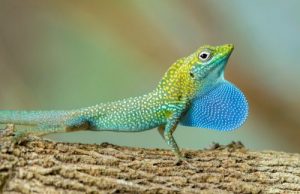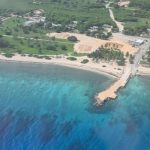Visiting scientist studies invasive threat to local anole
(CNS): Inbar Maayan, a graduate student in biology at Harvard University, spent the summer in Grand Cayman to study one of the less conspicuous invasive species that are finding their way to our shores. The impact of the brown anole on Cayman’s indigenous blue anole is an important line of research because it could help scientists understand how indigenous species survive invasions and changing conditions.
Working with local volunteers Vaughn Bodden, Morgan Ebanks and the Department of Environment’s Terrestrial Resources Unit, with funding from the National Geographic Society, Maayan learned that the invasion of the brown anole may not be harming our own species after all.
In the preliminary findings of the study, which Maayan has written up in the latest edition of the DOE’s magazine, Flicker, she said that the invading brown anoles are relatively sparse and are “mostly keeping out of the way of the local lizards”.
The scientists collected over 500 lizards, which they analysed and measured in their habitat and the lab. Maayan said the initial observations are encouraging and inspire hope, given the detrimental impact introduced species often have and especially as the blue-throated anole is the sole endemic representative of its genus in Grand Cayman.
Maayan said that studying these cases is not only of great scientific value but of critical conservation value as well.
“While some species will be able to adapt – and even thrive – in an age of increasingly rampant invasions, many others will not be able to cope with rapidly changing conditions. It is more crucial than ever that we understand the factors affecting how species adapt and take action to conserve our planet’s diverse but increasingly fragile biological communities,” she added.
To read all about the study and other work of the DoE Terrestrial Resources Unit, visit the Flicker page on the DoE website.
Category: Land Habitat, Science & Nature




































My goodness, even the lizards are confused and threatened. what a shame!
Is this an April Fool’s joke?? ONE invasive species at a TIME please!!!!!!!!!!!!
I live in Gun Bay now and lived in George Town growing up. All the greens I’ve seen were in GT and all the browns I’ve seen were in Gun Bay.
Don’t they have have locales? Up east it is much drier and the vegetation is different- adapted to a semi-arid environment.
There are more invasive species here than this little lizard.
They are of the homo sapiens species. They come here and enjoy and benefit from the financial and social benefits that are afforded here but at the same time are not content with our ways and customs which made us what we are. They then take advantage of their financial and social positions to influence decisions which legally change the moral fibre of our society and try to make us into what we are not!
Perhaps a funded study could be initiated on how to rid ourselves of the invasive species.
I can see how they are definitely a threat to the local aholes.
“They come here and enjoy and benefit from the financial and social benefits”
Pretty sure those exist because of them 😉
Would be nice to see both brown and blue side by side to see their differences
CNS: Follow the link to the Flicker magazine.